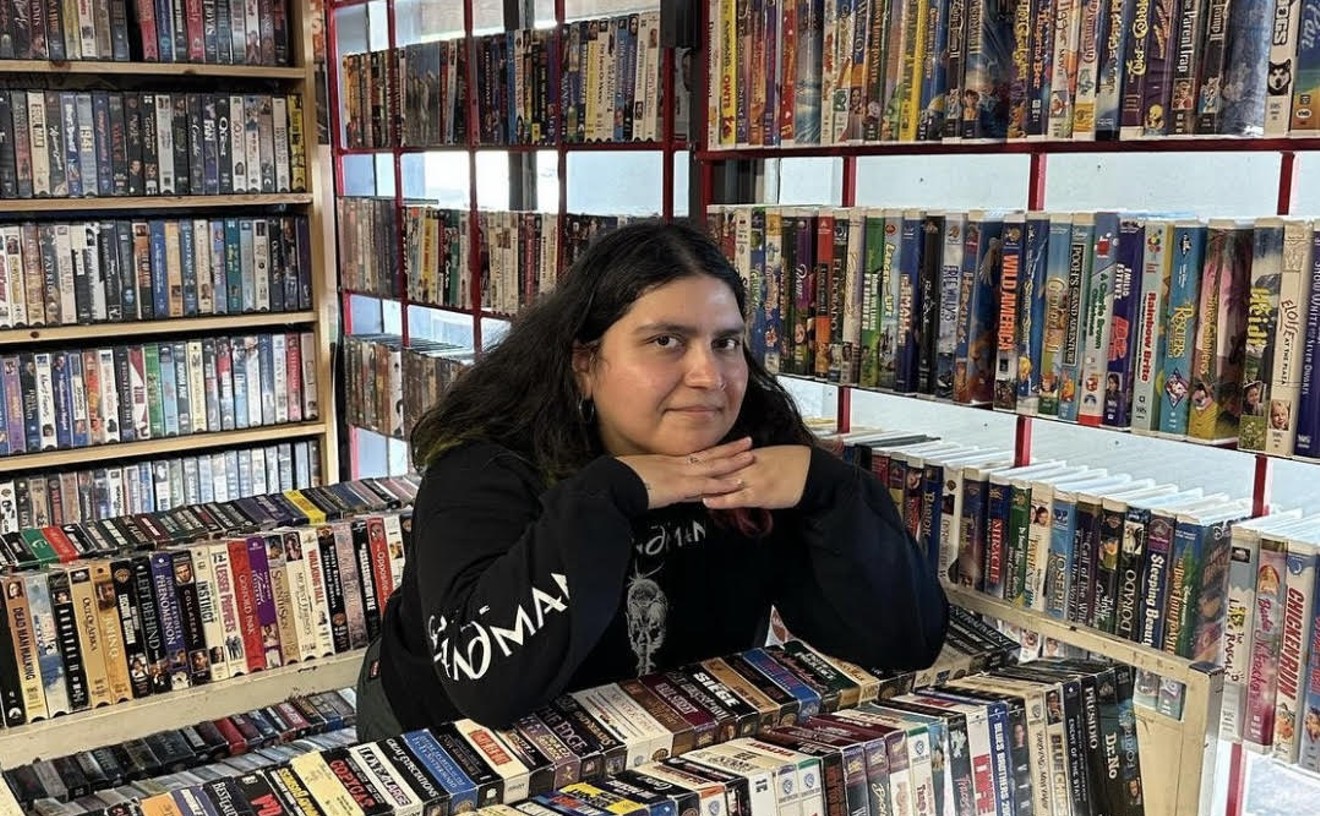Dallas Medianale, an experimental film festival programmed by the Video Association of Dallas, has been going on at the McKinney Avenue Contemporary (3120 McKinney Ave.) since January 9. I went to the opening night, which featured screenings and a series of intermedia performances, including an awesome display by a duo called Cracked Ray Tube, who assembled a tower of old TVs and synced audio to a kaleidoscope of images for a mesmerizing, trippy effect. The event was free, like all of the Medianale events, but I was still happily surprised to find the reasonably large black box theater at the MAC packed that night; attendees spilled out of chairs onto the floor.
This past weekend marked the opening of Call and Response, a video art exhibit in one of the MAC galleries that's co-curated by Charles Dee Mitchell and Danielle Avram-Morgan. Mitchell has curated events for the Video Association of Dallas in the past, and he decided to enlist a co-pilot for this Medianale exhibit, which features a number of iconic video artists including Bruce Nauman and Francis Alys. Mitchell knew Avram-Morgan from The Power Station, a non-profit promoting contemporary art projects in Dallas, and he invited her to choose half of the artists to be presented.
Mitchell selected video artists Nauman, Alys and Joe Sola; Avram-Morgan chose Mika Stansell, Tara Merenda Nelson and Gary Hill. They agreed upon Owen Kydd. "He was already on my long list," Mitchell says.
Alys' contract stipulated that his films be displayed in their own room, so his installation will be replaced with Mika Stansell's midway through the exhibit, which is on view during MAC gallery hours through March 7. Mitchell says that Call and Response has no real theme, although he and Avram-Morgan worked to balance the show in terms of how many pieces have sound and how many are silent. Where did the name come from, then? "I guess you could say I called, and she [Avram-Morgan] responded," he says with a laugh.
Mitchell walked me through the gallery Wednesday night, and I got to hear a little bit about each of the pieces on view. Some of the video art in Call and Response is quite funny, and the video that greets you in the lobby sets the humorous tone. It shows Montreal-based artist John Boyle-Singfield singing Google's Terms of Service. Mitchell didn't initially intend to feature the video, but he liked it and they discovered they had an empty wall to fill.
"There's also a karaoke version," Mitchell says. "Just the words. No music or anything, you're supposed to make up your own tune. If this is a test of patience, it's really a test of patience."
The first work we visited in the gallery was by Tara Merenda Nelson, an artist from Rochester. It's a four-tier projection entitled "End of an Empire." The tiers compose an image of Rochester's empty Kodak Tower, shot with four different technologies -- 16 mm film, super 8 mm film, 35 mm slide and video -- from the same angle, in the same light. Apparently the equipment was designed to break, and the 16 mm, uppermost portion wasn't functioning when I saw it. Mitchell explained Nelson's intention to "show it until there's nothing left" as a metaphor for Kodak's bankruptcy. The overall effect is almost disturbingly serene. "Her husband is also credited because to get the light they had to both be operating different equipment," explains Mitchell. "The super 8, the 16, take the slide and run the video. They wanted to balance the light and get it all at one time."
"Where did Bruce go?" Mitchell asks, as we turn to Bruce Nauman's piece, "Walking in an Exaggerated Manner Around the Perimeter of a Square." Made in the late '60s, it shows famed artist Nauman at 25, pacing around a square delineated on the floor of his studio. "One of his earliest quotes that this work came directly out of is that art is what happens when the artist is in the studio," Mitchell says. "So he did a whole series of the artist in the studio doing meaningless, repetitive things ... he was a real pioneer of video art." Nauman began as a sculptor, and Mitchell made an interesting connection between Nauman's sculptures and his video art. "He was a sculptor primarily but this can also be looked at as sculptural," he says. "He's using his body in time."
Next we checked out "Joe Sola's Studio Visits," in which Sola invites curators and other artists to visit him at his studio. After a minute or so of serious art talk, things take a startling and hilarious turn, when Sola excuses himself from the conversation to jump through a nearby closed window. "He trained with stunt people to learn how to fall," Mitchell says. "He's diving onto crash pads. I find it very satisfying [to hear the crash and watch him fall]." And he's right, it's very satisfying. I can't wait to check out Sola's other works, which frankly, sound like they would make great network television. "He's also in a video called riding roller coasters with male porn stars," Mitchell says. "In another one he suited up in football gear and had a middle school football team dogpile him."
"Composition, Warren Street Studio" and "Framing the Floor" are described as "moving photographs" by Owen Kydd, and they're the pieces that Mitchell and Avram-Morgan unanimously agreed to acquire for the exhibit. "Composition" shows a plastic bag, gently flapping in the wind. "[That one's] almost busy compared to a lot of what he does," Mitchell says. "They're very simple set-ups, presented as paintings or photographs, only they happen to move."
The conflicting sounds of several of the pieces, played without headphones, make it somewhat difficult to hear in the space. I couldn't exactly make out what was being said in Gary Hill's Mediations, but that difficulty actually related to the work's themes and it was neat nonetheless. As audio of a person talking plays, Hill gradually pours sand onto the concave speaker. The speaker's vibrations cause the sand to bounce initially, but as the sand weights the speaker down, the sound becomes increasingly muffled. "It's very much about making sound visible," Mitchell says.
Finally we visited Francis Alys' Children's Game series, an ongoing project that Alys began in 1999. The series -- which is up to 15 films currently -- depicts children around the world playing games unique to their region. Alys is an international artist, and he films children at play wherever his work happens to take him. "[The project asks] what do they [the children] have in common? What's unique to the place? ... But as much as anything it's about how beautiful these children are playing these games. Although one of the games does involved pulling the legs off of grasshoppers." The film I watched showed Mexican children playing musical chairs or sillas. Back-to-back, the films would run about an hour and a half. But you don't need to watch them from start to finish. The beauty of Call and Response is that you can take a quick 30-minute tour and get a good sense of it. Or you can stay longer to really consider each piece. It's free and it's fun -- although it was a luxury to have a guide, there wasn't so much on view that it was over-stimulating, and none of the pieces were particularly difficult. Perhaps it's because, in 2015, we're all so adapted to watching things on screens, but video art feels approachable in a way that not all art does.
This was the Video Association of Dallas' first year to put on Dallas Medianale, but it appears to have been a great success. Mitchell says there have already been meetings to discuss Medianale's future, and that it's likely to become a biennial event. In addition to Call and Response, there's plenty of special programming to check out before this year's festival wraps. Check out Roger Beebe's performance at CentralTrak this Monday, January 26 or attend Medianale's closing party at the MAC on February 28, which will feature a series of screenings curated by Carolyn Sortor.
For more information on Dallas Medianale and a full schedule of events, visit videofest.org.











